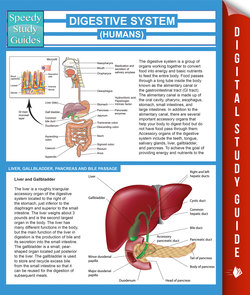Читать книгу Digestive System (Humans) (Speedy Study Guides) - Speedy Publishing - Страница 2
ОглавлениеDIGESTIVE SYSTEM
(HUMANS)
Microvilli
Blood
capillaries
Lacteal
Glands
Absorptive
cells
Arteriole
Venule
Gl tract
mucosal
layer
Liver (bile)
Gall bladder
Common
bile duct
Duodenum
Ascending
colon
Caecum
Appendix
Nasopharynx
Mouth
Oropharynx
Mastication and
secretion of
salivary amylase
Oesophagus
Stomach
Pancreas
Jejunum
Transverse colon
Descending colon
Ileum
Sigmoid colon
Rectum
Anus
Hydrochloric acid
Pepsinogen
Intrinsic factor
Pancreatic enzymes
The digestive system is a group of organs working together to convert food into energy and basic nutrients to feed the entire body. Food passes through a long tube inside the body known as the alimentary canal or the gastrointestinal tract (GI tract). The alimentary canal is made up of the oral cavity, pharynx, esophagus, stomach, small intestines, and large intestines. In addition to the alimentary canal, there are several important accessory organs that help your body to digest food but do not have food pass through them. Accessory organs of the digestive system include the teeth, tongue, salivary glands, liver, gallbladder, and pancreas. To achieve the goal of providing energy and nutrients to the
LIVER, GALLBLADDER, PANCREAS AND BILE PASSAGE
Liver and Gallbladder
